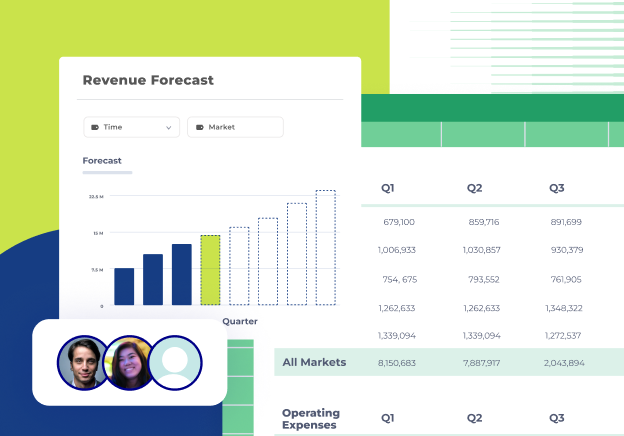A closer look at financial risk management
Financial risk management involves identifying, assessing, and prioritizing various types of financial risks to minimize their impact on an organization. In other words, it's all about spotting potential problems before they become big issues and figuring out how to deal with them.
There are several types of risks to keep an eye on:
- Market risk: The possibility of losing money on an investment
- Credit risk: The possibility of a loss resulting from a borrower's failure to repay a loan or meet contractual obligations
- Liquidity risk: The possibility that an individual, business, or financial institution cannot meet its short-term debt obligations
- Operational risk: The uncertainties and hazards a company faces when conducting its daily activities (e.g., a system failure)
With new economic trends, tech innovations, and regulations popping up all the time, financial risk is always changing. This means businesses need to be flexible and ready to adapt.
For finance and FP&A leaders, the goal is to identify these risks early and put plans in place to manage them. This helps keep organizations stable and on the path to long-term success.

Data analytics and predictive modeling for financial risk management
Data analytics and predictive modeling are powerful tools that help finance leaders manage risks more effectively. But what exactly are they, and how do they work?
Data analytics involves examining large sets of data to uncover hidden patterns, correlations, and insights. It lets you analyze past and current data to understand what has happened and why. This helps you identify trends, spot anomalies, and gain insights that can inform better decision-making.
Predictive modeling, on the other hand, uses statistical techniques and machine learning algorithms to predict future outcomes based on historical data. These models can forecast potential risks and opportunities by analyzing past data, helping organizations prepare and respond proactively.
Why are these tools relevant and useful for financial risk management?
- Early risk identification: Analyzing data helps spot trends and patterns that may indicate emerging risks, allowing you to address them before they become significant issues.
- Informed decision-making: Data-driven insights help you make more informed decisions, reducing uncertainty and improving risk management strategies.
- Efficiency and accuracy: Automated tools and models can process vast amounts of data quickly and accurately, saving time and reducing human error.
How to use data analytics and predictive modeling for financial risk management
-
Collect and clean your data: Ensure you have access to high-quality data from various sources, such as financial statements, market data, and operational records. Clean and preprocess the data to remove any inconsistencies or errors.
-
Choose the right tools: Leverage tools and software that are tailored to your needs. Cube Software, for instance, offers real-time data, advanced analytics, and scenario planning (more on this later) to help with risk management. Other popular options include:
-
Tableau for data visualization: This tool helps in creating interactive and shareable dashboards, which provide a clear insight into data. Tableau also integrates seamlessly with Cube so you can sync visualization and operational data, tie operational data to your key metrics, budgets, and forecasts, and use Cube's analytical tools to explore integrated data through dashboards and spreadsheets.
-
Python for customized data analysis solutions: With libraries like Pandas, Python is versatile for creating customized data analysis and predictive models. You can learn how to use Python for finance (for free!) on sites like Datacamp.
-
R for statistical computing and graphics: R is widely used for statistical analysis and graphical representation of data, making it a valuable tool for risk management. Just like Python, you can learn how to use R for free on Datacamp.
-
Analyze historical data: Use data analytics tools, such as Cube, Excel, or Python libraries like Pandas, to examine historical data. Apply statistical techniques, such as regression analysis or time series analysis, to identify trends, correlations, and anomalies. For example, you might use regression analysis to determine the relationship between interest rates and investment returns or time series analysis to track revenue trends over different quarters. This will help you understand past risks and their impacts by revealing how certain factors have influenced financial outcomes.
-
Build predictive models: Develop predictive models using statistical techniques and machine learning algorithms. Techniques such as linear regression, logistic regression, and decision trees can help predict financial outcomes based on historical data. Machine learning algorithms like random forests, support vector machines, and neural networks can further enhance your predictive capabilities. For instance, you might use linear regression to forecast future sales based on past performance, or a random forest algorithm to predict the likelihood of loan defaults. These models enable you to anticipate potential risks and opportunities, allowing for more proactive and strategic decision-making.
-
Monitor and update models: Continuously monitor the performance of your predictive models and update them with new data to ensure their accuracy and relevance.
Tips for effective financial risk management using data analytics and predictive modeling
- Start small: Begin with a specific risk or area of concern and gradually expand your efforts as you gain confidence and expertise.
- Collaborate across teams: Work closely with data scientists, IT professionals, and other departments to ensure you have the right expertise and resources.
- Stay updated: Keep up with the latest developments in data analytics and predictive modeling to leverage new tools and techniques.

Stress testing and scenario analysis for financial risk management
Stress testing and scenario analysis are essential techniques for assessing how different adverse conditions can impact your organization’s financial health.
Stress testing involves simulating extreme but plausible adverse conditions to evaluate how they would affect the financial stability of an organization. For example, stress testing might assess the impact of a severe economic downturn, a sudden spike in interest rates, or a significant drop in market prices.
Scenario analysis involves creating detailed narratives of possible future events and analyzing their effects on the organization. Unlike stress testing, which focuses on extreme conditions, scenario analysis explores a range of potential outcomes, including both negative and positive scenarios.
Steps to implement these techniques in your organization
- Identify key variables: Determine the critical variables that affect your financial outcomes, such as interest rates, exchange rates, market prices, and economic indicators.
- Develop scenarios: Create a variety of scenarios, including both stress scenarios (extreme but plausible) and standard scenarios (a range of possible future events). Each scenario should include specific assumptions about the key variables.
- Run simulations: Use financial models to simulate the impact of each scenario on your organization's financial statements and key performance indicators. This might involve using FP&A software like Cube or creating customized models in Excel or other analytics platforms.
- Analyze results: Evaluate the results of the simulations to understand the potential impacts on your organization. Identify which scenarios pose the greatest risks and which areas of your business are most vulnerable.
- Develop mitigation strategies: Based on the analysis, develop strategies to mitigate the identified risks. This might include diversifying investments, adjusting risk management policies, or implementing contingency plans.
- Regular updates and reviews: Continuously update your stress testing and scenario analysis models to reflect new data and changing conditions. Regularly review and refine your scenarios to ensure they remain relevant.
Examples of stress testing applications by industry
- Biotech: A biotech company might use stress testing to simulate the impact of a major regulatory change or a sudden halt in clinical trials. Scenario analysis could help them plan for potential supply chain disruptions or fluctuations in funding availability.
- Financial services: Financial services firms can use stress testing to assess the effects of a sudden economic downturn or significant market volatility on their portfolios. Scenario analysis can help them prepare for changes in regulatory environments or shifts in customer behavior.
- Manufacturing: A manufacturing company might use stress testing to evaluate the impact of a significant supply chain disruption or a sharp increase in raw material costs. Scenario analysis can help them anticipate demand fluctuations or changes in trade policies.
- SaaS: A SaaS company could use stress testing to simulate the effects of a major cybersecurity breach or significant changes in subscription renewal rates. Scenario analysis can help them plan for rapid technological advancements or shifts in market competition.
By implementing stress testing and scenario analysis, finance and FP&A leaders can better anticipate potential risks and develop strategies to safeguard their organizations against financial volatility.

Risk avoidance: Strengthening cybersecurity measures
Cyber risks are increasingly threatening the financial stability of organizations across industries. Cyberattacks, data breaches, and ransomware can lead to significant financial losses, operational disruptions, and reputational damage. As financial data becomes more digitized and interconnected, the vulnerability to cyber threats escalates, making robust cybersecurity measures essential.
Strategies to protect against cyber threats
- Implement comprehensive security protocols: Establish robust security policies and procedures that cover all aspects of your IT infrastructure, including network security, data encryption, and access controls.
- Regular security audits and assessments: Conduct frequent security audits and vulnerability assessments to identify and address potential weaknesses in your systems.
- Employee training and awareness: Educate employees about cybersecurity best practices, such as recognizing phishing attempts, using strong passwords, and reporting suspicious activities.
- Invest in advanced cybersecurity tools: Utilize advanced cybersecurity solutions like intrusion detection systems, firewalls, and endpoint protection to safeguard your network and data.
- Incident response planning: Develop and regularly update an incident response plan to ensure a swift and effective response to any cybersecurity incidents.
How to build a risk-aware organizational culture
A risk-aware culture is crucial for effective risk management. When employees at all levels understand the importance of risk management and are actively engaged in identifying and mitigating risks, the organization becomes more resilient and better prepared to handle uncertainties.
Strategies for fostering a risk-aware culture within the organization
- Leadership commitment: Ensure that senior leaders demonstrate a strong commitment to risk management by incorporating it into the organization's strategic goals and leading by example.
- Clear communication: Communicate the importance of risk management throughout the organization, making it a part of everyday conversations and decision-making processes.
- Training and education: Provide ongoing training and education on risk management principles and practices to all employees, ensuring they have the knowledge and skills to identify and address risks.
- Encourage reporting and feedback: Create an environment where employees feel comfortable reporting potential risks and providing feedback on risk management practices without fear of reprisal.
- Integrate risk management into processes: Embed risk management into the organization's processes and procedures, making it a fundamental aspect of project planning, performance reviews, and strategic initiatives.
Conclusion: no risk, more reward
Managing financial risk is crucial in today's unpredictable world. Using data analytics, predictive modeling, stress testing, and strong cybersecurity measures can make a big difference. Building a risk-aware culture is also key to staying resilient.
Want to see how Cube can help you easily manage financial risk? Schedule a demo with us and discover the tools and insights Cube offers to keep your organization secure.



.png)









.png)

.png)




.webp)
.png)
![Best strategic planning software for CFOs [2025 review]](https://www.cubesoftware.com/hubfs/Frame%2014-1.png)